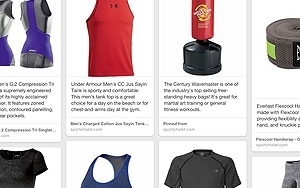Commentary
How Pinterest Rich Pins Becomes Google AdWords 2.0
- by Laurie Sullivan , Staff Writer @lauriesullivan, November 3, 2014
 Adding descriptions or text to images in social sites like Pinterest provides detail, allowing a brand's
data feed to more closely match the intent of the consumer. In Pinterest, Rich Pins allows brands to serve ads based on product information such as real-time pricing, available stock, and direct links
to the product page. That's what happens when a startup's investors with a background in search contribute to the direction of the company.
Adding descriptions or text to images in social sites like Pinterest provides detail, allowing a brand's
data feed to more closely match the intent of the consumer. In Pinterest, Rich Pins allows brands to serve ads based on product information such as real-time pricing, available stock, and direct links
to the product page. That's what happens when a startup's investors with a background in search contribute to the direction of the company.
Google drives most of the marketplace volume with product listing ads (PLAs) compared to Amazon and eBay, but one vendor using social data to build out intent-based targeting reveals opportunities in Pinterest. DataPop recently released the advertising platform OmniAds, which turns catalog feeds into advertisements. It supports numerous platforms other than Google and Bing, such as Pinterest, Polyvore, Ebay, and Amazon.
"I think the ad platform in Pinterest has a chance to be AdWords 2.0 because there's a social component, but you have intent signals to determine what the consumers care about," said Jason Lehmbeck, DataPop founder. "Brands find they can get the same type of performance as PLAs in Pinterest."
Advertisers spent 73% more in Q3 2014 on Google PLAs and Bing Product Ads combined, compared with the year-ago quarter. In fact, 27% of all Google search clicks came from PLAs, according to estimates from the Rimm-Kaufman Group.
The share of all site visits generated by social media sites rose slightly year-on-year from 2% to 2.2%. Facebook produced 53% of all social media-driven site visits, while Pinterest generated 18%, per RKG. While Facebook remains the largest social media traffic driver, producing 53% of social visits on average, a number of retail sites are generating more referrals from Pinterest than Facebook.
Sports Chalet -- which supports 75,000 products -- serves the perfect image, price and title in Google PLAs against matching queries, but it also connects with consumers on Pinterest by serving seasonally relevant products like snowboards in the perfect picture.
Rich Pins requires that brands have the most up-to-date connection for the products when the brand or consumers Pin them. Through Rich Pins, the brand can update title, price, promotions or offerings related to the product. If Google is where consumers search for products, Pinterest is where consumers discover products, per Lehmbeck.
Brands can learn the best way to highlight the snowboards or winter apparel. OmniAds analyzes the product in context. Was someone riding the snowboard or was it propped up against the side of a building in a snowbank? DataPops' OmniAds platform helps to support these ads across search and social, generating pins and optimizing Rich Pins.
When consumers Pin products or information about sports, OmniAds identifies that as a signal. The platform can understand the words that consumers write along with the Pins, so if they Pin a snowboard from Sports Chalet and describe it as an advanced snowboard that's blue, the platform sees the keywords as intent signals, similar to search when analyzing queries.
The platform infers the image through the description and the connected URL. Brands also can use that social data to build Google Shopping Ads.
Several data sources augment the brand's data feed such as an API and publicly available data by crawling sites or through third-party data. DataPop's product knowledge graph has built up intelligence on millions and millions of products.



